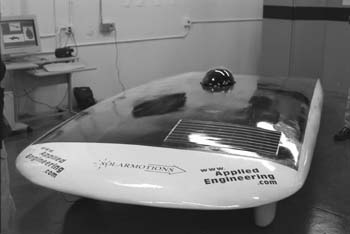![[Metroactive Features]](http://metroactive.com/features/gifs/feat468.gif)
[ Features Index | San Jose | Metroactive Central | Archives ]
Light Speed
 Local engineer rolls out solar car, prepares to run Australian outback race By Jim Rendon MARTIN KOEBLER SMILES A LOT as he shakes hands and talks with one small group of people after another inside a large workroom at Applied Engineering in San Jose. The doughnuts and bagels are lined up on the folding-leg table, the coffee is flowing, and everyone seems interested, even a little excited. "We need $1.2 million to go up against Honda and Toyota. We have the experience and know-how to be at that level," he says to a small group gathered around him. Small talk is not his strong suit. Koebler, a 29-year-old Fremont resident, is not pitching the next .com or lines of invisible code vital to the next generation of automobiles. He's pitching a 12-foot-long Chiclet-shaped car on three wheels that is powered solely by the sun. And he's not getting a lot of help. His blue-and-yellow prototype sits in the corner of the room, drawing the largest group of the 40 or so guests. The car looks like a rounded platform with a helmet-sized bubble on top for the driver to see out of. Koebler hopes to one day break the solar-car world speed record of 99 miles an hour. But his more immediate goal is to bring home the gold in October at the World Solar Car Challenge, a 2,000-mile race across Australia, traversing some of the starkest desert on the planet. The problem is that no one is excited or interested enough to actually fund the project. A few valley companies like Applied Engineering and Space Systems/Loral (where Koebler works as an electrical systems engineer) have donated materials and space, but only Steven Kirsch, CEO of Infoseek, has put down cold, hard cash. Steven Lorenz, chairman of the AHI Group, a high-tech incubator, is fundraising for Koebler. He hopes Koebler's vision, not to mention some of the new technologies his team is innovating, will catch some valleyite's eye and checkbook. "I think this kind of purity of spirit is what Silicon Valley is all about," Lorenz says. "It's not just all about money and stock options, but it's about someone who can truly and passionately develop technologies that are beneficial to everyone." The group, known as Solarmotions, is developing a highly efficient electric motor, feather-light, air-pressurized carbon fiber wheels and a suspension system that can tilt to optimize its angle toward the sun so the solar panels get the best rays. But these gearhead technologies are not causing a stir in the land of ones and zeros, and they have hardly drawn interest from Detroit either. But Koebler and his team are used to shoestring budgets. Three years ago, when Koebler and his friends were students at Stanford and Berkeley, they managed to build a car in just a month on little more than their enthusiasm. "We would sleep next to the cars. We would work and then doze off. Then the adrenaline kicked in and we'd work again. That's what it's all about," says Jacob Tuft, an electrical engineer with the project who works at Loral Space Systems. Though they had done no road testing, the team was still able to finish seventh in the qualifying round. But the race itself proved a little tougher. "It was frustrating," Tuft says. "We would fly by cars and then break down, then pass the same cars again and do that three or four times a day." Nonetheless, they were the top-placing American team, coming in 25th out of 40 international teams. But the event is more than fun, Koebler says, it is often where tomorrow's technologies are born. And the United States, he says, has turned its back on the event. Since GM won the race in 1987, no major U.S. auto company has entered the race. However, GM's EV1, the sleek electric two-seater making its appearance in valley parking lots, bears the fruits of the company's first foray into solar-car racing in the 1980s, says Dick Thompson, a spokesman for the company. The light aluminum body and aerodynamics are the direct results of lessons learned in the demanding environment of solar-car racing. Since solar cars generate about as much power as it takes to run a space heater, minimizing weight and increasing efficiency are developers' mantras. That extreme environment forces innovation, Koebler says. And since electric cars work under the same kinds of constraints, there is a lot to be learned. One GM solar-car innovation is likely to be a staple of the auto industry in the future. The direct drive motor, which completely eliminates the transmission, is standard in the EV1 and will only become more common, Thompson says. More innovations like that are sure to come, Lorenz says. "I joke with him [Koebler] that he may be the next Henry Ford," Lorenz says. "Maybe the next phase of motor vehicle development will be centered in Silicon Valley. We've got the work force and technology." [ San Jose | Metroactive Central | Archives ]
|
From the June 10-16, 1999 issue of Metro, Silicon Valley's Weekly Newspaper.
Copyright © 1999 Metro Publishing Inc. Metroactive is affiliated with the Boulevards Network.
For more information about the San Jose/Silicon Valley area, visit sanjose.com.